Smart E-Textile Systems: A Review for Healthcare Applications
Abstract
:1. Introduction
2. Smart Textiles
2.1. E-Textile System
2.2. E-Medical/Healthcare E-Textile Systems
2.2.1. Diagnostic and Monitoring Devices
2.2.2. Therapeutic Devices
3. Development of Healthcare E-Textiles for Commercial Purposes
4. Research Progress in Healthcare E-Textile System Development
4.1. Development of Diagnostic and Monitoring Devices
4.2. Therapeutic Devices
5. Challenges for Healthcare E-Textiles
6. Conclusions
Author Contributions
Funding
Institutional Review Board Statement
Informed Consent Statement
Data Availability Statement
Conflicts of Interest
References
- Ankhili, A.; Tao, X.; Cochrane, C.; Coulon, D.; Koncar, V. Washable and Reliable Textile Electrodes Embedded into Underwear Fabric for Electrocardiography (ECG) Monitoring. Materials 2018, 11, 256. [Google Scholar] [CrossRef] [Green Version]
- Wu, H.; Huang, Y.; Xu, F.; Duan, Y.; Yin, Z. Energy Harvesters for Wearable and Stretchable Electronics: From Flexibility to Stretchability. Adv. Mater. 2016, 28, 9881–9919. [Google Scholar] [CrossRef]
- Waqar, S.; Wang, L.; John, S. Piezoelectric Energy Harvesting from Intelligent Textiles. In Electronic Textiles; Elsevier: Amsterdam, The Netherlands, 2015; pp. 173–197. ISBN 978-0-08-100201-8. [Google Scholar]
- Bahru, R.; Hamzah, A.A.; Mohamed, M.A. Thermal Management of Wearable and Implantable Electronic Healthcare Devices: Perspective and Measurement Approach. Int. J. Energy Res. 2020, 45, 1517–1534. [Google Scholar] [CrossRef]
- Hussain, M.M.; El-Atab, N. Handbook of Flexible and Stretchable Electronics; CRC Press: Boca Raton, FL, USA, 2019. [Google Scholar]
- Wang, L.; Fu, X.; He, J.; Shi, X.; Chen, T.; Chen, P.; Wang, B.; Peng, H. Application Challenges in Fiber and Textile Electronics. Adv. Mater. 2020, 32, 1901971. [Google Scholar] [CrossRef] [PubMed]
- Mecnika, V.; Scheulen, K.; Anderson, C.F.; Hörr, M.; Breckenfelder, C. Joining Technologies for Electronic Textiles. In Electronic Textiles; Elsevier: Amsterdam, The Netherlands, 2015; pp. 133–153. ISBN 978-0-08-100201-8. [Google Scholar]
- uz Zaman, S.; Tao, X.; Cochrane, C.; Koncar, V. Understanding the Washing Damage to Textile ECG Dry Skin Electrodes, Embroidered and Fabric-Based; Set up of Equivalent Laboratory Tests. Sensors 2020, 20, 1272. [Google Scholar] [CrossRef] [PubMed] [Green Version]
- Tseghai, G.B.; Malengier, B.; Fante, K.A.; Nigusse, A.B.; Langenhove, L.V. Integration of Conductive Materials with Textile Structures, an Overview. Sensors 2020, 20, 6910. [Google Scholar] [CrossRef] [PubMed]
- Pang, Y.; Yang, Z.; Yang, Y.; Ren, T. Wearable Electronics Based on 2D Materials for Human Physiological Information Detection. Small 2020, 16, 1901124. [Google Scholar] [CrossRef]
- Ismar, E.; Tao, X.; Rault, F.; Dassonville, F.; Cochrane, C. Towards Embroidered Circuit Board From Conductive Yarns for E-Textiles. IEEE Access 2020, 8, 9. [Google Scholar] [CrossRef]
- Valentine, L.; Ballie, J.; Bletcher, J.; Robertson, S.; Stevenson, F. Design Thinking for Textiles: Let’s Make It Meaningful. Design J. 2017, 20, S964–S976. [Google Scholar] [CrossRef]
- Scataglini, S.; Andreoni, G.; Gallant, J. A Review of Smart Clothing in Military. In Proceedings of the 2015 Workshop on Wearable Systems and Applications—WearSys ’15, Florence, Italy, 18 May 2015; pp. 53–54. [Google Scholar]
- Abed, A.; Cochrane, C.; Boussu, F.; Cherkaoui, O.; Elmoznine, R. Design and Development of a Piezo-Resistive Sensor Based on PEDOT: PSS Applied to Sisal’s Natural Fiber for Monitoring of 3D Warp Interlock Fabric. IOP Conf. Ser. Mater. Sci. Eng. 2020, 827, 012019. [Google Scholar] [CrossRef]
- Kim, G.; Vu, C.C.; Kim, J. Single-Layer Pressure Textile Sensors with Woven Conductive Yarn Circuit. Appl. Sci. 2020, 10, 2877. [Google Scholar] [CrossRef]
- Park, S.; Jayaraman, S. Smart Textiles: Wearable Electronic Systems. MRS Bull. 2003, 28, 585–591. [Google Scholar] [CrossRef]
- Park, S.; Jayaraman, S. Enhancing the Quality of Life through Wearable Technology. IEEE Eng. Med. Biol. Mag. 2003, 22, 41–48. [Google Scholar] [CrossRef]
- Tao, X. Smart Technology for Textiles and Clothing—Introduction and Overview. In Smart Fibres, Fabrics and Clothing; Elsevier: Amsterdam, The Netherlands, 2001; pp. 1–6. ISBN 978-1-85573-546-0. [Google Scholar]
- Koncar, V. Introduction to Smart Textiles and Their Applications. In Smart Textiles and Their Applications; Elsevier: Amsterdam, The Netherlands, 2016; pp. 1–8. ISBN 978-0-08-100574-3. [Google Scholar]
- Koncar, V. Smart Textiles for Monitoring and Measurement Applications. In Smart Textiles for In Situ Monitoring of Composites; Elsevier: Amsterdam, The Netherlands, 2019; pp. 1–151. ISBN 978-0-08-102308-2. [Google Scholar]
- Stoppa, M.; Chiolerio, A. Wearable Electronics and Smart Textiles: A Critical Review. Sensors 2014, 14, 11957–11992. [Google Scholar] [CrossRef] [Green Version]
- Rambausek, L. Textronics—Definition, Development and Characterization of Fibrous Organic Field Effect Transistors. Ph.D. Thesis, Ghent University, Ghent, Belhium, 2014. [Google Scholar]
- Simegnaw, A.A.; Malengier, B.; Rotich, G.; Tadesse, M.G.; Van Langenhove, L. Review on the Integration of Microelectronics for E-Textile. Materials 2021, 14, 5113. [Google Scholar] [CrossRef]
- de Mulatier, S.; Nasreldin, M.; Delattre, R.; Ramuz, M.; Djenizian, T. Electronic Circuits Integration in Textiles for Data Processing in Wearable Technologies. Adv. Mater. Technol. 2018, 3, 1700320. [Google Scholar] [CrossRef]
- ISO ISO/TR 23383. 2020. Available online: https://www.iso.org/cms/render/live/fr/sites/isoorg/contents/data/standard/07/53/75383.html (accessed on 15 March 2021).
- Nayak, R.; Wang, L.; Padhye, R. Electronic Textiles for Military Personnel. In Electronic Textiles; Elsevier: Amsterdam, The Netherlands, 2015; pp. 239–256. ISBN 978-0-08-100201-8. [Google Scholar]
- Kuroda, T.; Takahashi, H.; Masuda, A. Chapter 9—Woven Electronic Textiles. In Wearable Sensors, 2nd ed.; Sazonov, E., Ed.; Academic Press: Oxford, UK, 2021; pp. 249–275. ISBN 978-0-12-819246-7. [Google Scholar]
- Fleury, A.; Sugar, M.; Chau, T. E-Textiles in Clinical Rehabilitation: A Scoping Review. Electronics 2015, 4, 173–203. [Google Scholar] [CrossRef] [Green Version]
- Teferra, M.N.; Kourbelis, C.; Newman, P.; Ramos, J.S.; Hobbs, D.; Clark, R.A.; Reynolds, K.J. Electronic Textile Electrocardiogram Monitoring in Cardiac Patients: A Scoping Review Protocol. JBI Database Syst. Rev. Implement. Rep. 2019, 17, 147–156. [Google Scholar] [CrossRef] [PubMed]
- Smart Textiles and Their Applications—1st Edition. Available online: https://www.elsevier.com/books/smart-textiles-and-their-applications/koncar/978-0-08-100574-3 (accessed on 27 August 2021).
- Gopalsamy, C.; Park, S.; Rajamanickam, R.; Jayaraman, S. The wearable motherboard TM: The first generation of adaptive and responsive textile structures (ARTS) for medical applications. Virtual Real. 2005, 4, 152–168. [Google Scholar]
- Shah, A.; Ahirrao, S.; Phansalkar, S.; Kotecha, K. Survey on: Applications of Smart Wearable Technology in Health Insurance. IOP Conf. Ser. Mater. Sci. Eng. 2021, 1042, 012025. [Google Scholar] [CrossRef]
- Tao, X.; Huang, T.-H.; Shen, C.-L.; Ko, Y.-C.; Jou, G.-T.; Koncar, V. Bluetooth Low Energy-Based Washable Wearable Activity Motion and Electrocardiogram Textronic Monitoring and Communicating System. Adv. Mater. Technol. 2018, 3, 1700309. [Google Scholar] [CrossRef]
- Kim, H.; Kang, T.-H.; Ahn, J.; Han, H.; Park, S.; Kim, S.J.; Park, M.-C.; Paik, S.; Hwang, D.K.; Yi, H.; et al. Spirally Wrapped Carbon Nanotube Microelectrodes for Fiber Optoelectronic Devices beyond Geometrical Limitations toward Smart Wearable E-Textile Applications. ACS Nano 2020, 14, 17213–17223. [Google Scholar] [CrossRef] [PubMed]
- Wearable Healthcare Devices Market—Global Forecast to 2025|MarketsandMarkets. Available online: https://www.marketsandmarkets.com/Market-Reports/wearable-medical-device-market-81753973.html?__cf_chl_captcha_tk__=pmd_cVzQgXHOplhxpc1dXJMJDiAr6z_kBujbP4vmF2_k0AU-1635425122-0-gqNtZGzNAzujcnBszQe9 (accessed on 31 October 2021).
- Bystricky, T.; Moravcova, D.; Kaspar, P.; Soukup, R.; Hamacek, A. A Comparison of Embroidered and Woven Textile Electrodes for Continuous Measurement of ECG. In Proceedings of the 2016 39th International Spring Seminar on Electronics Technology (ISSE), Pilsen, Czech Republic, 18–22 May 2016; pp. 7–11. [Google Scholar]
- Ankhili, A.; Tao, X.; Cochrane, C.; Koncar, V.; Coulon, D.; Tarlet, J.-M. Ambulatory Evaluation of ECG Signals Obtained Using Washable Textile-Based Electrodes Made with Chemically Modified PEDOT:PSS. Sensors 2019, 19, 416. [Google Scholar] [CrossRef] [PubMed] [Green Version]
- Medical Smart Textile Market Scope and Challenges 2018–2027 by Players, Technology and Applications|MarketResrarchFuture.Com|Medgadget. Available online: https://www.medgadget.com/2018/08/medical-smart-textile-market-scope-and-challenges-2018-2027-by-players-technology-and-applications-marketresrarchfuture-com.html (accessed on 22 December 2020).
- Scataglini, S.; Moorhead, A.P.; Feletti, F. A Systematic Review of Smart Clothing in Sports: Possible Applications to Extreme Sports. Muscle Ligaments Tendons J. 2020, 10, 333. [Google Scholar] [CrossRef]
- Sport T-Shirt. Available online: https://emglare.com/products/sport-tshirt (accessed on 21 December 2020).
- Gao, Y.; Yu, L.; Yeo, J.C.; Lim, C.T. Flexible Hybrid Sensors for Health Monitoring: Materials and Mechanisms to Render Wearability. Adv. Mater. 2020, 32, 1902133. [Google Scholar] [CrossRef]
- Pulse Oximeter Market|By Product, Type, Technology|Global Forecast to 2026|MarketsandMarkets. Available online: https://www.marketsandmarkets.com/Market-Reports/pulse-oximeter-market-68168578.html (accessed on 31 October 2021).
- Hexoskin (Carré Technologies Inc.) Hexoskin Smart Shirts—Cardiac, Respiratory, Sleep & Activity Metrics. Available online: https://www.hexoskin.com/ (accessed on 16 November 2021).
- Huang, C.-T.; Shen, C.-L.; Tang, C.-F.; Chang, S.-H. A Wearable Yarn-Based Piezo-Resistive Sensor. Sens. Actuators A Phys. 2008, 141, 396–403. [Google Scholar] [CrossRef]
- Gao, W.; Emaminejad, S.; Nyein, H.Y.Y.; Challa, S.; Chen, K.; Peck, A.; Fahad, H.M.; Ota, H.; Shiraki, H.; Kiriya, D.; et al. Fully Integrated Wearable Sensor Arrays for Multiplexed in Situ Perspiration Analysis. Nature 2016, 529, 509–514. [Google Scholar] [CrossRef] [Green Version]
- Gaubert, V.; Gidik, H.; Koncar, V. Boxer Underwear Incorporating Textile Moisture Sensor to Prevent Nocturnal Enuresis. Sensors 2020, 20, 3546. [Google Scholar] [CrossRef]
- Rymarczyk, T.; Vejar, A.; Nita, P.; Stefaniak, B.; Wos, M.; Oleszek, M. Using Electrical Tomography for Remote Monitoring Cardiopulmonary State of Patients by Complementary Investigation Techniques. In Proceedings of the 2019 19th International Symposium on Electromagnetic Fields in Mechatronics, Electrical and Electronic Engineering (ISEF), Nancy, France, 29–31 August 2019; pp. 1–2. [Google Scholar]
- Mordon, S.; Cochrane, C.; Tylcz, J.B.; Betrouni, N.; Mortier, L.; Koncar, V. Light Emitting Fabric Technologies for Photodynamic Therapy. Photodiagn. Photodyn. Ther. 2015, 12, 1–8. [Google Scholar] [CrossRef] [Green Version]
- Gaubert, V.; Gidik, H.; Bodart, N.; Koncar, V. Quantification of the Silver Content of a Silver-Plated Nylon Electrode According to the Nature of the Laundering Detergent. IOP Conf. Ser. Mater. Sci. Eng. 2020, 827, 012033. [Google Scholar] [CrossRef]
- Quandt, B.M.; Scherer, L.J.; Boesel, L.F.; Wolf, M.; Bona, G.-L.; Rossi, R.M. Body-Monitoring and Health Supervision by Means of Optical Fiber-Based Sensing Systems in Medical Textiles. Adv. Healthc. Mater. 2015, 4, 330–355. [Google Scholar] [CrossRef]
- Grancarić, A.M.; Jerković, I.; Koncar, V.; Cochrane, C.; Kelly, F.M.; Soulat, D.; Legrand, X. Conductive Polymers for Smart Textile Applications. J. Ind. Text. 2018, 48, 612–642. [Google Scholar] [CrossRef]
- NeoMedLight Bilicocoon®. Available online: https://www.neomedlight.com/bilicocoon/ (accessed on 22 December 2020).
- Parvin, F.; Islam, S.; Urmy, Z.; Ahmed, S. A study on the textile materials applied in human medical treatment. J. Physiother. Rehabil. Stud. 2020, 1, 2566. [Google Scholar] [CrossRef]
- Baldoli, I.; Mazzocchi, T.; Paoletti, C.; Ricotti, L.; Salvo, P.; Dini, V.; Laschi, C.; Francesco, F.D.; Menciassi, A. Pressure Mapping with Textile Sensors for Compression Therapy Monitoring. Proc. Inst. Mech. Eng. H 2016, 230, 795–808. [Google Scholar] [CrossRef] [PubMed]
- Andrew Cohen Heart-Monitoring T-Shirt. Available online: https://www.sporttechie.com/smart-textile-company-kymira-cardiac-monitoring-tshirt-athletes/ (accessed on 15 March 2021).
- Xiaomi Mijia Cardiogram T-Shirt: Smart T-Shirt with ECG Measurement. Xiaomi Planet. 2020. Available online: https://xiaomiplanets.com/Xiaomi-mijia-cardiogram-t-shirt-1/ (accessed on 12 February 2021).
- Daniely, H. A T-Shirt That Monitors Your Heart. HealthWatch Ltd.|Healthcare Wearables. 2017. Available online: https://healthwatchtech.com/a-t-shirt-that-monitors-your-heart/ (accessed on 16 March 2021).
- BioMan + Products & Services. AiQ Smart Clothing. Available online: https://www.aiqsmartclothing.com/product-service/bioman-plus/#tab-id-3 (accessed on 12 February 2021).
- T-Shirt Short Sleeve + HRM. Available online: https://store.sensoriafitness.com/t-shirt-short-sleeve-hrm/ (accessed on 21 December 2020).
- The Next Phase for Medical Wearables—Verdict Medical Devices. Available online: https://medical-technology.nridigital.com/medical_technology_jun21/next_phase_medical_wearables (accessed on 31 October 2021).
- Nag, A.; Mukhopadhyay, S.C.; Kosel, J. Wearable Flexible Sensors: A Review. IEEE Sens. J. 2017, 17, 3949–3960. [Google Scholar] [CrossRef] [Green Version]
- Bosowski, P.; Hoerr, M.; Mecnika, V.; Gries, T.; Jockenhövel, S. Design and Manufacture of Textile-Based Sensors. In Electronic Textiles; Elsevier: Amsterdam, The Netherlands, 2015; pp. 75–107. ISBN 978-0-08-100201-8. [Google Scholar]
- Trung, T.Q.; Lee, N.-E. Flexible and Stretchable Physical Sensor Integrated Platforms for Wearable Human-Activity Monitoringand Personal Healthcare. Adv. Mater. 2016, 28, 4338–4372. [Google Scholar] [CrossRef]
- van den Brand, J.; de Kok, M.; Koetse, M.; Cauwe, M.; Verplancke, R.; Bossuyt, F.; Jablonski, M.; Vanfleteren, J. Flexible and Stretchable Electronics for Wearable Health Devices. Solid-State Electron. 2015, 113, 116–120. [Google Scholar] [CrossRef]
- Fukuma, N.; Hasumi, E.; Fujiu, K.; Waki, K.; Toyooka, T.; Komuro, I.; Ohe, K. Feasibility of a T-Shirt-Type Wearable Electrocardiography Monitor for Detection of Covert Atrial Fibrillation in Young Healthy Adults. Sci. Rep. 2019, 9, 11768. [Google Scholar] [CrossRef] [PubMed] [Green Version]
- Hong, Y.J.; Jeong, H.; Cho, K.W.; Lu, N.; Kim, D. Wearable and Implantable Devices for Cardiovascular Healthcare: From Monitoring to Therapy Based on Flexible and Stretchable Electronics. Adv. Funct. Mater. 2019, 29, 1808247. [Google Scholar] [CrossRef]
- Meghrazi, M.A.; Tian, Y.; Mahnam, A.; Bhattachan, P.; Eskandarian, L.; Kakhki, S.T.; Popovic, M.R. Multichannel ECG Recording from Waist Using Textile Sensors. Biomed. Eng. Online 2020, 19, 48. [Google Scholar] [CrossRef] [PubMed]
- Heo, J.S.; Hossain, M.F.; Kim, I. Challenges in Design and Fabrication of Flexible/Stretchable Carbon- and Textile-Based Wearable Sensors for Health Monitoring: A Critical Review. Sensors 2020, 20, 3927. [Google Scholar] [CrossRef]
- Arquilla, K.; Webb, A.; Anderson, A. Textile Electrocardiogram (ECG) Electrodes for Wearable Health Monitoring. Sensors 2020, 20, 1013. [Google Scholar] [CrossRef] [Green Version]
- Wang, J.; Soltanian, S.; Servati, P.; Ko, F.; Weng, M. A Knitted Wearable Flexible Sensor for Monitoring Breathing Condition. J. Eng. Fibers Fabr. 2020, 15, 155892502093035. [Google Scholar] [CrossRef]
- Shathi, M.A.; Chen, M.; Khoso, N.A.; Rahman, M.T.; Bhattacharjee, B. Graphene Coated Textile Based Highly Flexible and Washable Sports Bra for Human Health Monitoring. Mater. Des. 2020, 193, 108792. [Google Scholar] [CrossRef]
- Saleh, S.M.; Jusob, S.M.; Harun, F.K.C.; Yuliati, L.; Wicaksono, D.H.B. Optimization of Reduced GO-Based Cotton Electrodes for Wearable Electrocardiography. IEEE Sensors J. 2020, 20, 7774–7782. [Google Scholar] [CrossRef]
- Fu, Y.; Zhao, J.; Dong, Y.; Wang, X. Dry Electrodes for Human Bioelectrical Signal Monitoring. Sensors 2020, 20, 3651. [Google Scholar] [CrossRef]
- Nigusse, A.B.; Malengier, B.; Mengistie, D.A.; Tseghai, G.B.; Van Langenhove, L. Development of Washable Silver Printed Textile Electrodes for Long-Term ECG Monitoring. Sensors 2020, 20, 6233. [Google Scholar] [CrossRef]
- Kim, S.; Lee, S.; Jeong, W. EMG Measurement with Textile-Based Electrodes in Different Electrode Sizes and Clothing Pressures for Smart Clothing Design Optimization. Polymers 2020, 12, 2406. [Google Scholar] [CrossRef] [PubMed]
- Shi, J.; Liu, S.; Zhang, L.; Yang, B.; Shu, L.; Yang, Y.; Ren, M.; Wang, Y.; Chen, J.; Chen, W.; et al. Smart Textile-Integrated Microelectronic Systems for Wearable Applications. Adv. Mater. 2020, 32, 1901958. [Google Scholar] [CrossRef] [PubMed]
- Atakan, R.; Acikgoz Tufan, H.; Baskan, H.; Eryuruk, S.H.; Akalin, N.; Kose, H.; Li, Y.; Kursun Bahadir, S.; Kalaoglu, F. Design of an Electronic Chest-Band. IOP Conf. Ser. Mater. Sci. Eng. 2017, 254, 072002. [Google Scholar] [CrossRef] [Green Version]
- Cao, R.; Pu, X.; Du, X.; Yang, W.; Wang, J.; Guo, H.; Zhao, S.; Yuan, Z.; Zhang, C.; Li, C.; et al. Screen-Printed Washable Electronic Textiles as Self-Powered Touch/Gesture Tribo-Sensors for Intelligent Human–Machine Interaction. ACS Nano 2018, 12, 5190–5196. [Google Scholar] [CrossRef] [PubMed]
- Sliz, R.; Huttunen, O.-H.; Jansson, E.; Kemppainen, J.; Schroderus, J.; Kurkinen, M.; Fabritius, T. Reliability of R2R-Printed, Flexible Electrodes for e-Clothing Applications. Npj Flex. Electron. 2020, 4, 12. [Google Scholar] [CrossRef]
- Qureshi, Y.; Tarfaoui, M.; Lafdi, K.; Lafdi, K. A Flexible Strain Sensor Design Based on Ny-6 Yarn Coated with Ag Nanoparticles for Real Time Strain Monitoring Application. Int. J. Mech. Prod. Eng. 2019, 7, 18–21. [Google Scholar]
- Zhao, X.; Hua, Q.; Yu, R.; Zhang, Y.; Pan, C. Flexible, Stretchable and Wearable Multifunctional Sensor Array as Artificial Electronic Skin for Static and Dynamic Strain Mapping. Adv. Electron. Mater. 2015, 1, 1500142. [Google Scholar] [CrossRef]
- Zhang, X.; Zhong, Y. A Silver/Silver Chloride Woven Electrode with Convex Based on Electrical Impedance Tomography. J. Text. Inst. 2020, 112, 1067–1079. [Google Scholar] [CrossRef]
- Jin, H.; Matsuhisa, N.; Lee, S.; Abbas, M.; Yokota, T.; Someya, T. Enhancing the Performance of Stretchable Conductors for E-Textiles by Controlled Ink Permeation. Adv. Mater. 2017, 29, 1605848. [Google Scholar] [CrossRef] [PubMed]
- Logothetis, I.; Vatansever Bayramol, D.; Gil, I.; Dabnichki, P.; Pirogova, E. Evaluating Silver-Plated Nylon (Ag/PA66) e-Textiles for Bioelectrical Impedance Analysis (BIA) Application. Meas. Sci. Technol. 2020, 31, 075101. [Google Scholar] [CrossRef]
- Edmison, J.; Jones, M.; Lockhart, T.; Martin, T. An e-textile system for motion analysis. Stud. Health Technol. Inform. 2010, 108, 292. [Google Scholar]
- Afroj, S.; Tan, S.; Abdelkader, A.M.; Novoselov, K.S.; Karim, N. Highly Conductive, Scalable, and Machine Washable Graphene-Based E-Textiles for Multifunctional Wearable Electronic Applications. Adv. Funct. Mater. 2020, 30, 2000293. [Google Scholar] [CrossRef] [Green Version]
- Daňová, R.; Olejnik, R.; Slobodian, P.; Matyas, J. The Piezoresistive Highly Elastic Sensor Based on Carbon Nanotubes for the Detection of Breath. Polymers 2020, 12, 713. [Google Scholar] [CrossRef] [PubMed] [Green Version]
- Tang, Y.; Chang, R.; Zhang, L.; Yan, F.; Ma, H.; Bu, X. Electrode Humidification Design for Artifact Reduction in Capacitive ECG Measurements. Sensors 2020, 20, 3449. [Google Scholar] [CrossRef] [PubMed]
- Gong, Z.; Xiang, Z.; OuYang, X.; Zhang, J.; Lau, N.; Zhou, J.; Chan, C.C. Wearable Fiber Optic Technology Based on Smart Textile: A Review. Materials 2019, 12, 3311. [Google Scholar] [CrossRef] [PubMed] [Green Version]
- Cinquino, M.; Prontera, C.; Pugliese, M.; Giannuzzi, R.; Taurino, D.; Gigli, G.; Maiorano, V. Light-Emitting Textiles: Device Architectures, Working Principles, and Applications. Micromachines 2021, 12, 652. [Google Scholar] [CrossRef]
- Shen, J.; Chui, C.; Tao, X. Luminous Fabric Devices for Wearable Low-Level Light Therapy. Biomed. Opt. Express 2013, 4, 2925. [Google Scholar] [CrossRef] [PubMed] [Green Version]
- Mordon, S.; Thécua, E.; Ziane, L.; Lecomte, F.; Deleporte, P.; Baert, G.; Vignion-Dewalle, A. Light Emitting Fabrics for Photodynamic Therapy: Technology, Experimental and Clinical Applications. Transl. Biophotonics 2020, 2, e202000005. [Google Scholar] [CrossRef]
- Wang, J.; Lee, S.; Yokota, T.; Jimbo, Y.; Wang, Y.; Nayeem, M.O.G.; Nishinaka, M.; Someya, T. Nanomesh Organic Electrochemical Transistor for Comfortable On-Skin Electrodes with Local Amplifying Function. ACS Appl. Electron. Mater. 2020, 2, 3601–3609. [Google Scholar] [CrossRef]
- Shahariar, H.; Kim, I.; Bhakta, R.; Jur, J.S. Direct-Write Printing Process of Conductive Paste on Fiber Bulks for Wearable Textile Heaters. Smart Mater. Struct. 2020, 29, 085018. [Google Scholar] [CrossRef]
- Quandt, B.M.; Pfister, M.S.; Lübben, J.F.; Spano, F.; Rossi, R.M.; Bona, G.-L.; Boesel, L.F. POF-Yarn Weaves: Controlling the Light out-Coupling of Wearable Phototherapy Devices. Biomed. Opt. Express 2017, 8, 4316. [Google Scholar] [CrossRef] [Green Version]
- Ismar, E.; uz Zaman, S.; Tao, X.; Cochrane, C.; Koncar, V. Effect of Water and Chemical Stresses on the Silver Coated Polyamide Yarns. Fibers Polym. 2019, 20, 2604–2610. [Google Scholar] [CrossRef]
- uz Zaman, S.; Tao, X.; Cochrane, C.; Koncar, V. Launderability of Conductive Polymer Yarns Used for Connections of E-Textile Modules: Mechanical Stresses. Fibers Polym. 2019, 20, 2355–2366. [Google Scholar] [CrossRef]
- Rotzler, S.; Kallmayer, C.; Dils, C.; von Krshiwoblozki, M.; Bauer, U.; Schneider-Ramelow, M. Improving the Washability of Smart Textiles: Influence of Different Washing Conditions on Textile Integrated Conductor Tracks. J. Text. Inst. 2020, 111, 1766–1777. [Google Scholar] [CrossRef]
- Kazani, I.; De Mey, G.; Klepacko, R.; Hertleer, C.; Guxho, G.; Van Langenhove, L.; Napieralski, A. Influence of Dry Cleaning on the Electrical Resistance of Screen Printed Conductors on Textiles. Autex Res. J. 2016, 16, 146–153. [Google Scholar] [CrossRef] [Green Version]
- Kazani, I.; Declercq, F.; Scarpello, M.L.; Hertleer, C.; Rogier, H.; Vande Ginste, D.; De Mey, G.; Guxho, G.; Van Langenhove, L. Performance Study of Screen-Printed Textile Antennas after Repeated Washing. Autex Res. J. 2014, 14, 47–54. [Google Scholar] [CrossRef]
- Hwang, B.; Lund, A.; Tian, Y.; Darabi, S.; Müller, C. Machine-Washable Conductive Silk Yarns with a Composite Coating of Ag Nanowires and PEDOT:PSS. ACS Appl. Mater. Interfaces 2020, 12, 27537–27544. [Google Scholar] [CrossRef]
- Salavagione, H.J.; Shuttleworth, P.S.; Fernández-Blázquez, J.P.; Ellis, G.J.; Gómez-Fatou, M.A. Scalable Graphene-Based Nanocomposite Coatings for Flexible and Washable Conductive Textiles. Carbon 2020, 167, 495–503. [Google Scholar] [CrossRef]
- Liang, A.; Stewart, R.; Freire, R.; Bryan-Kinns, N. Effect of Bonding and Washing on Electronic Textile Stretch Sensor Properties. In Adjunct Proceedings of the 2019 ACM International Joint Conference on Pervasive and Ubiquitous Computing and Proceedings of the 2019 ACM International Symposium on Wearable Computers; ACM Press: London, UK, 2019; pp. 121–124. [Google Scholar]
- uz Zaman, S.; Tao, X.; Cochrane, C.; Koncar, V. E-Textile Systems Reliability Assessment—A Miniaturized Accelerometer Used to Investigate Damage during Their Washing. Sensors 2021, 21, 605. [Google Scholar] [CrossRef]
- WK61480 New Test Method for Durability of Smart Garment Textile Electrodes after Laundering. Available online: https://www.astm.org/DATABASE.CART/WORKITEMS/WK61480.htm (accessed on 21 December 2020).
- RA111. Electronically Integrated Textiles Test Methods. AATCC. Available online: https://aatcc.org/aatcc-committees/ra111-electronically-integrated-textiles-test-methods/ (accessed on 12 November 2021).
- IEC-TC 124 Dashboard > Projects: Work Programme, Publications, Maintenance Cycle, Project Files, TC/SC in Figures. Available online: https://www.iec.ch/dyn/www/f?p=103:38:0::::FSP_ORG_ID,FSP_APEX_PAGE,FSP_PROJECT_ID:20537,109,101883 (accessed on 5 January 2021).
- IPC-8921: Requirements for Woven and Knitted Electronic Textiles (E-Textiles) Integrated with Conductive Fibers, Conductive Yarns and/or Wires. Available online: https://shop.ipc.org/IPC-8921-English-D (accessed on 21 December 2020).

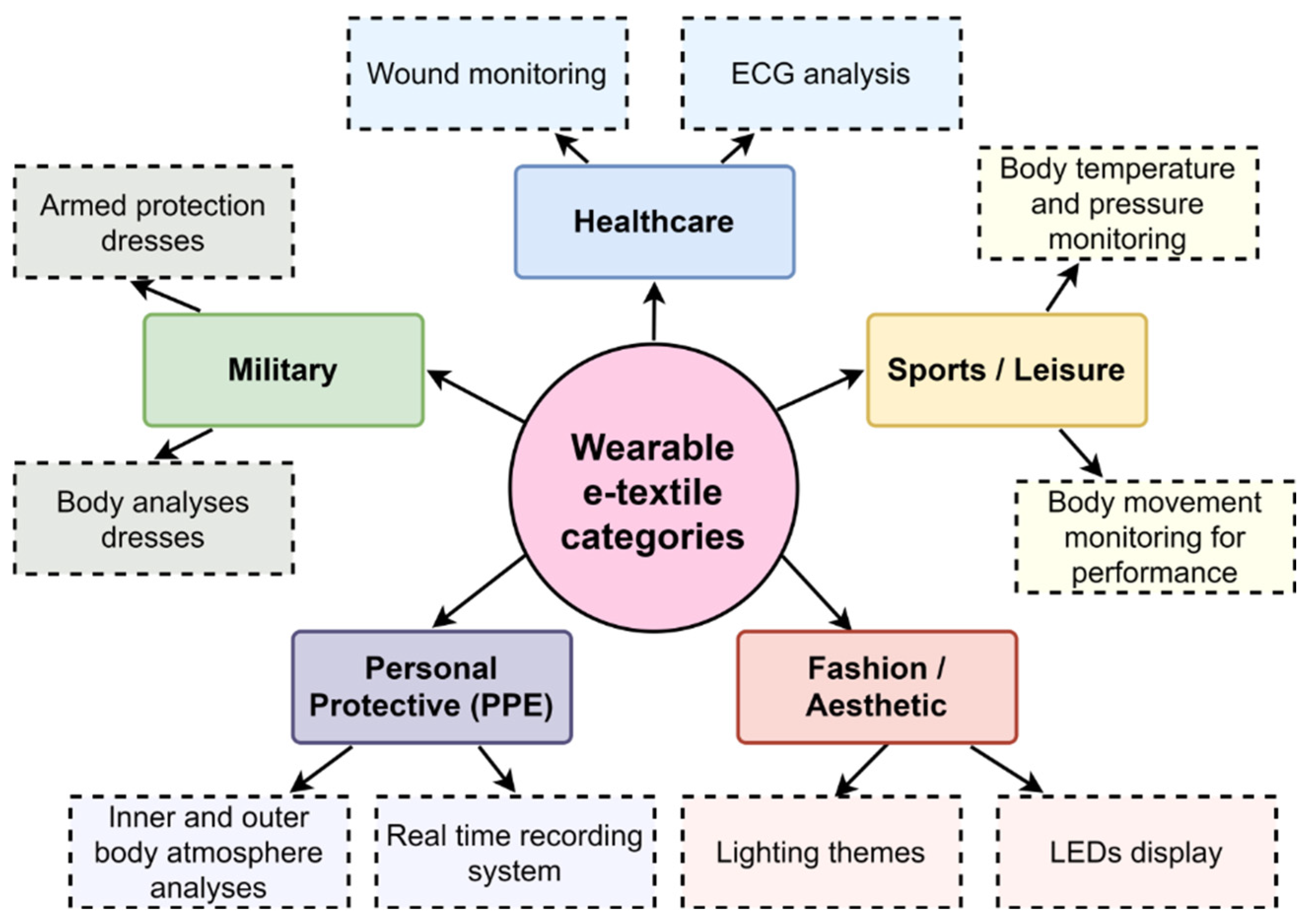
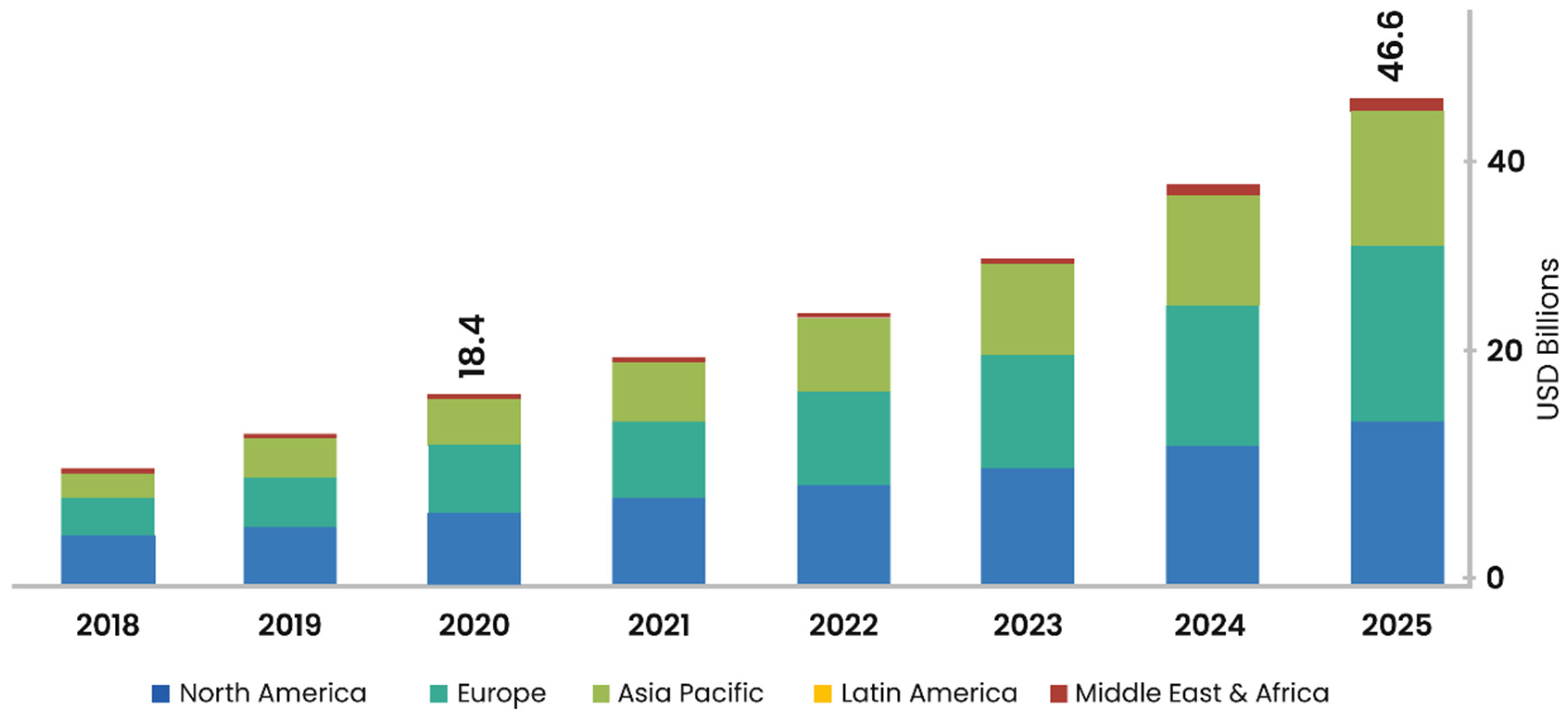
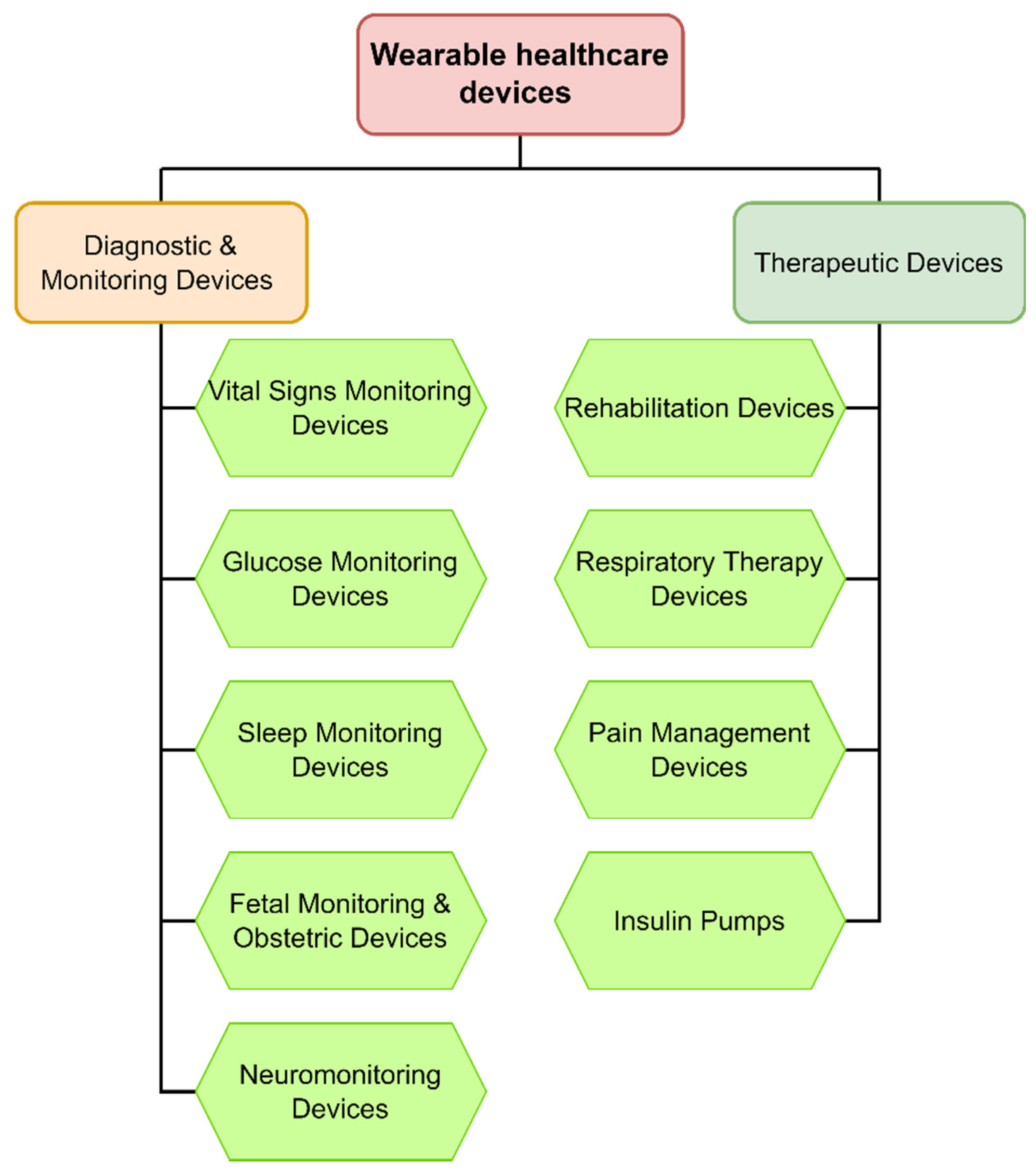

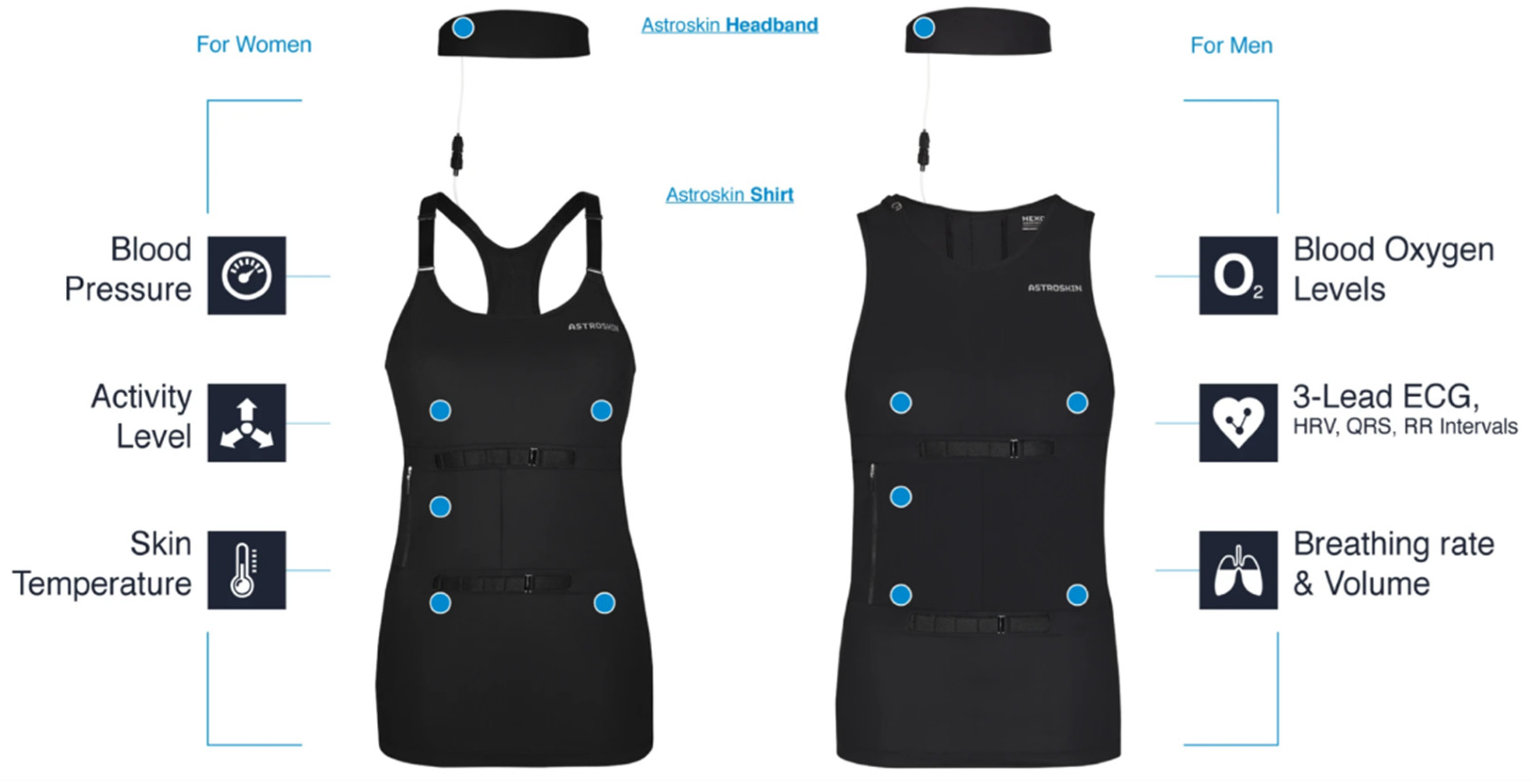



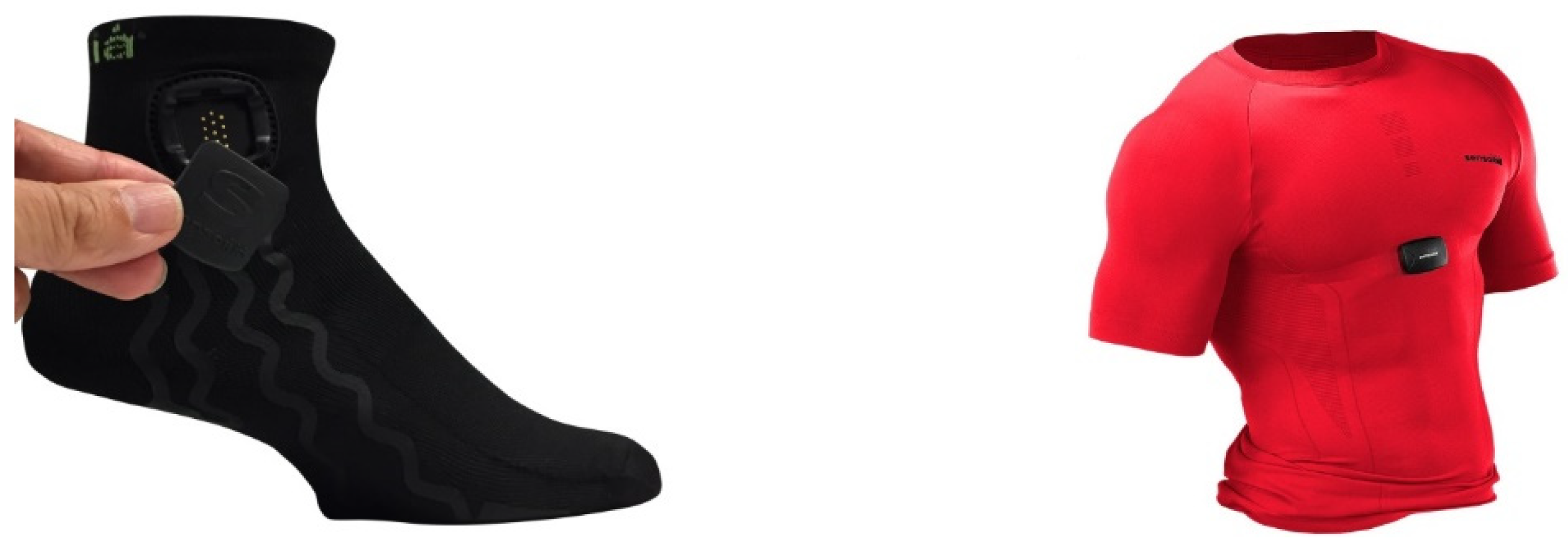
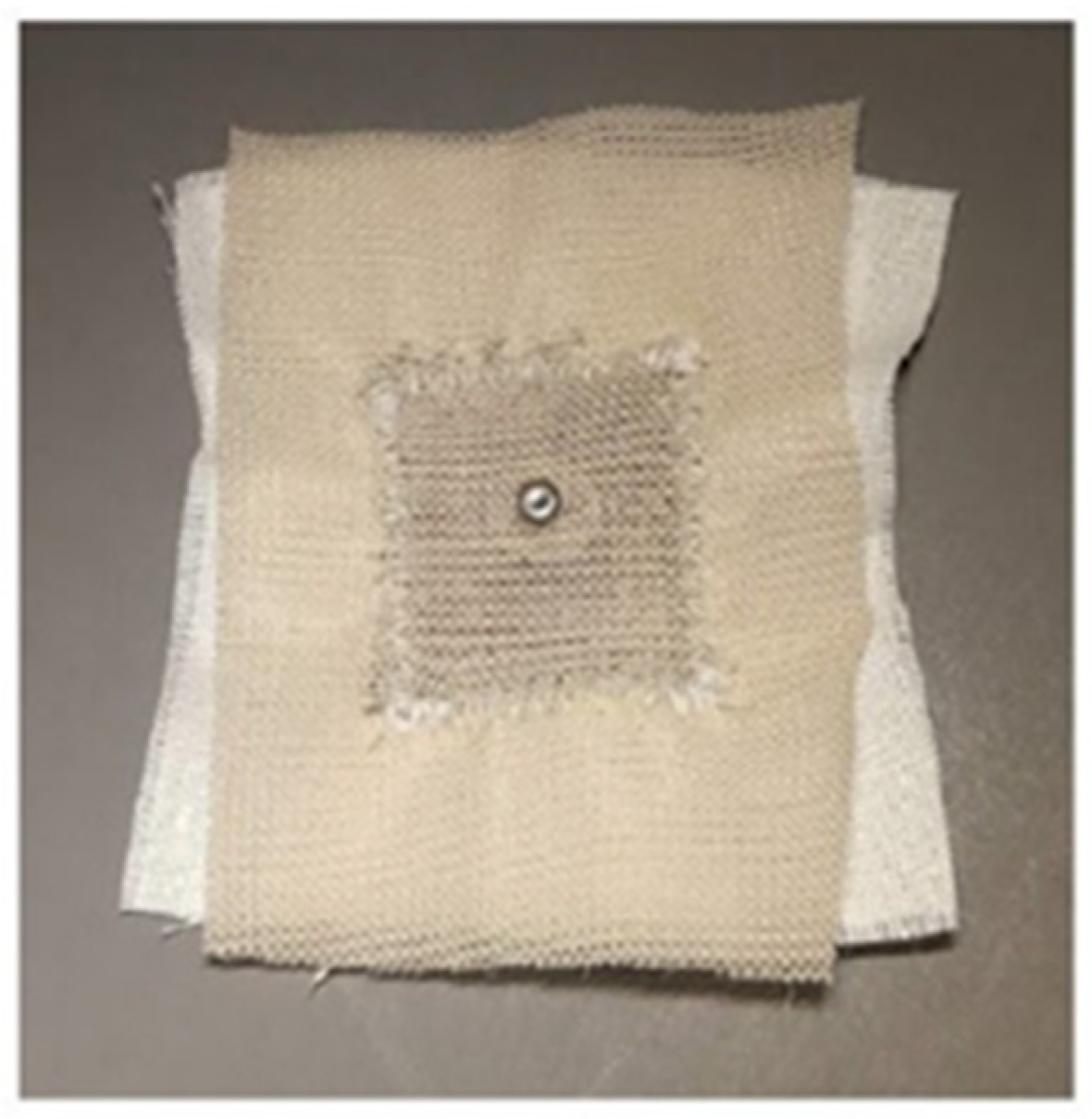
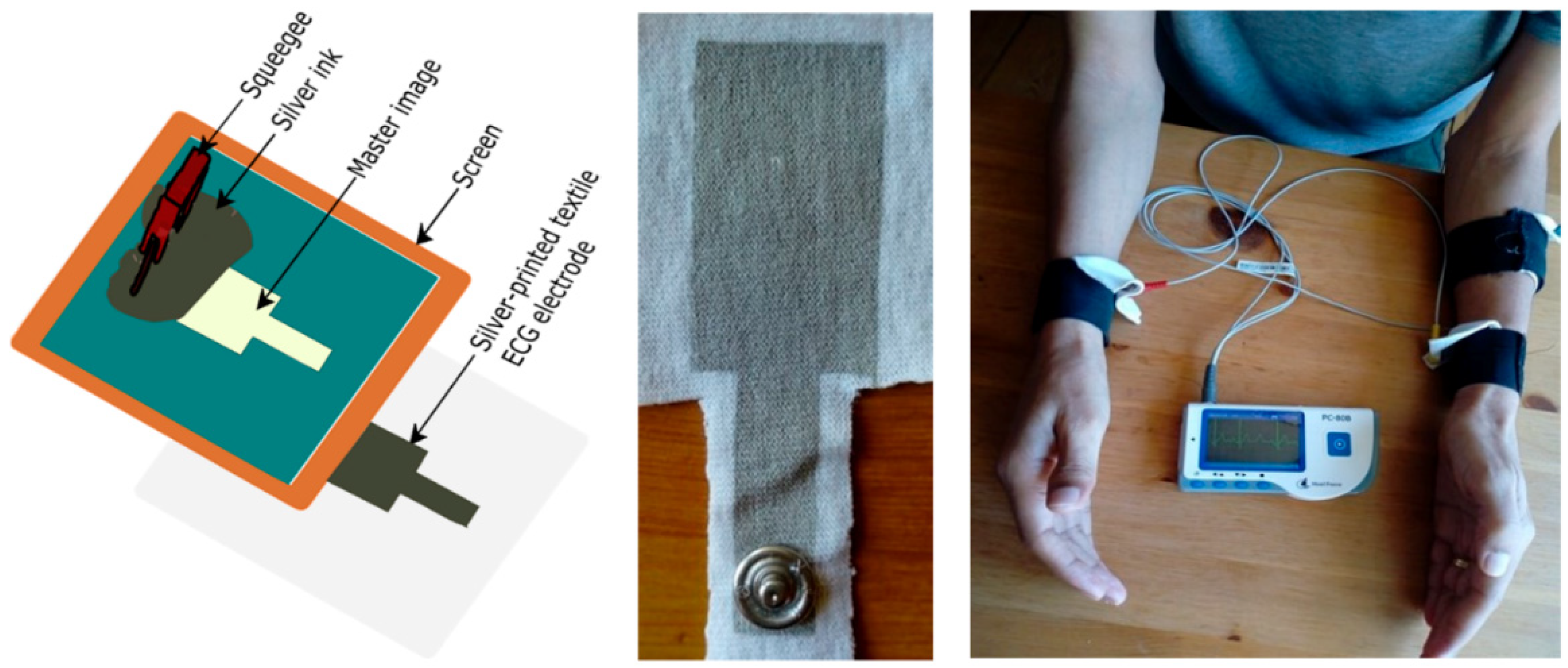
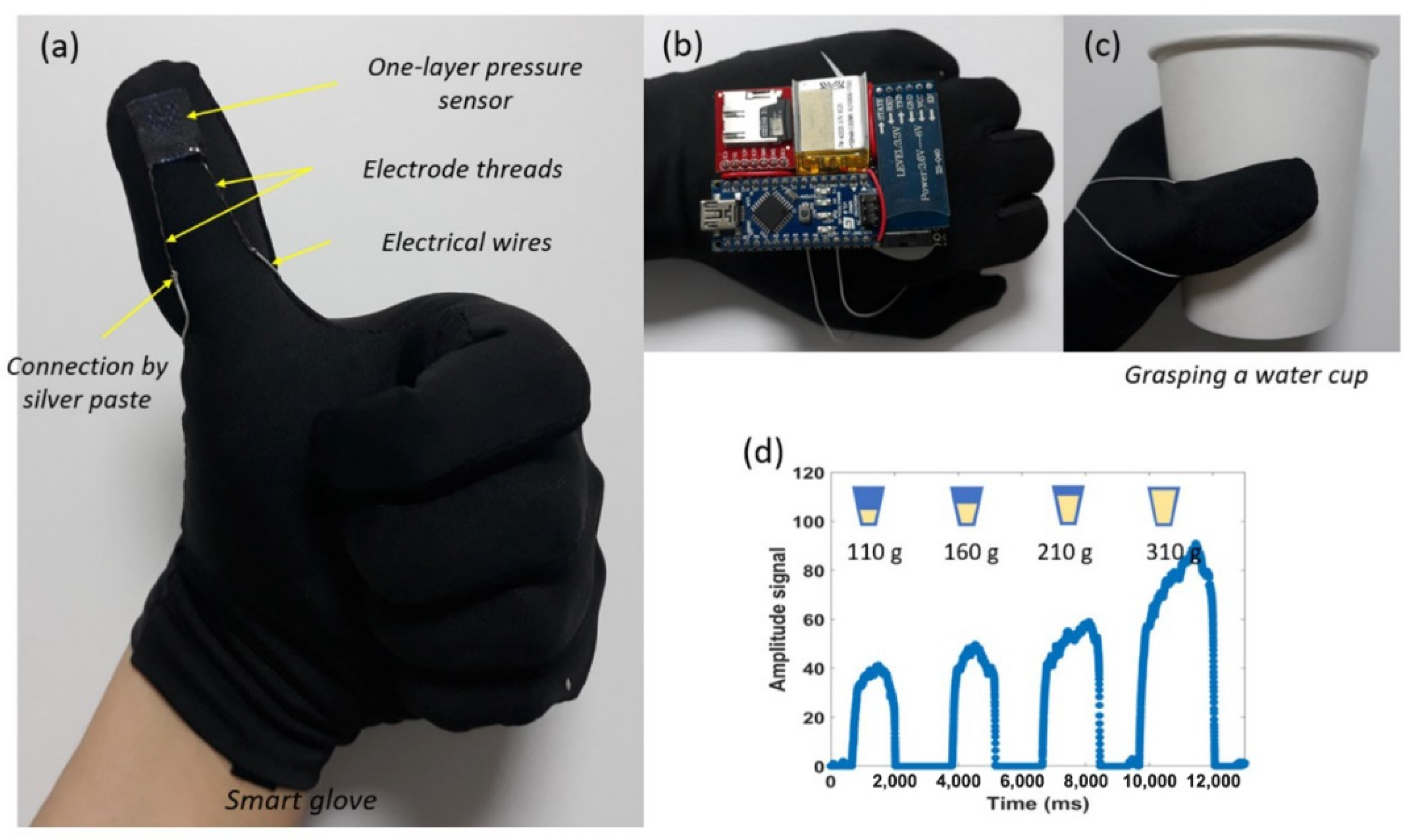
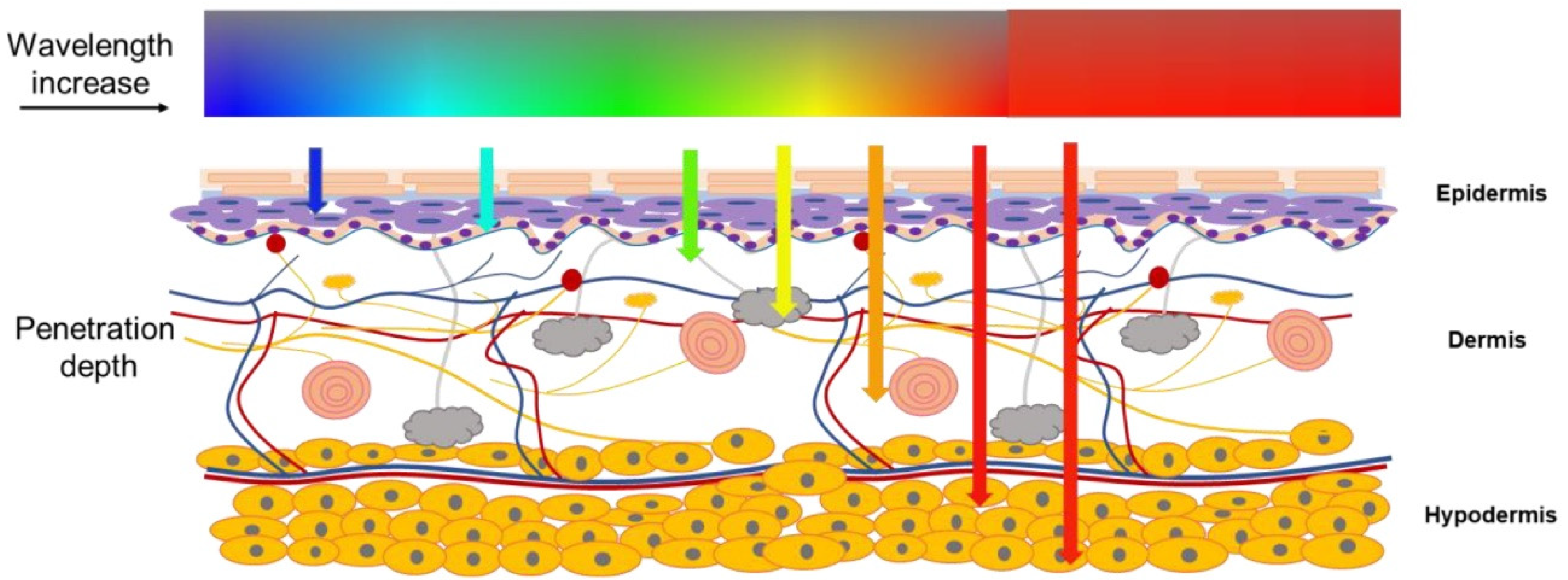
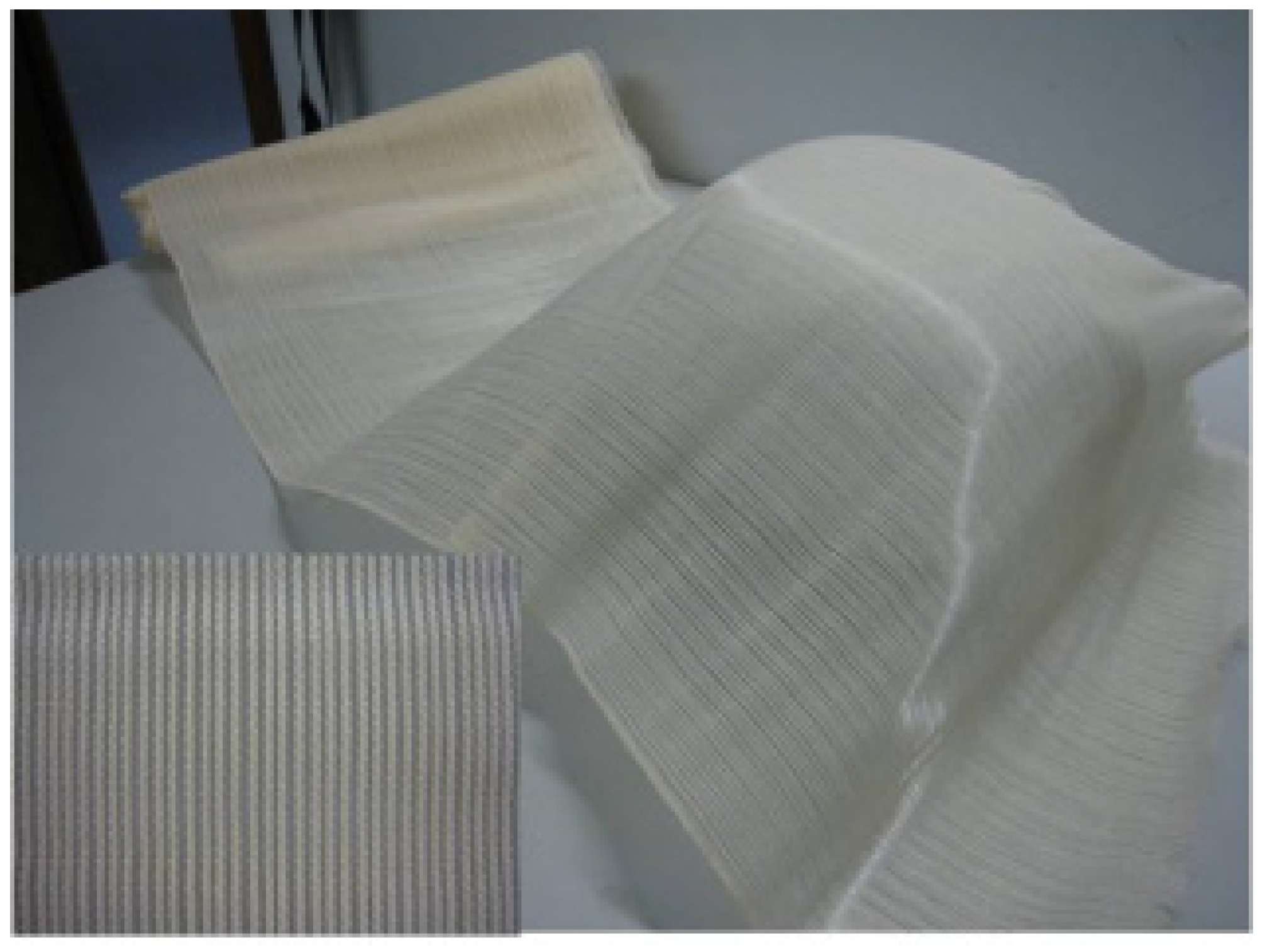
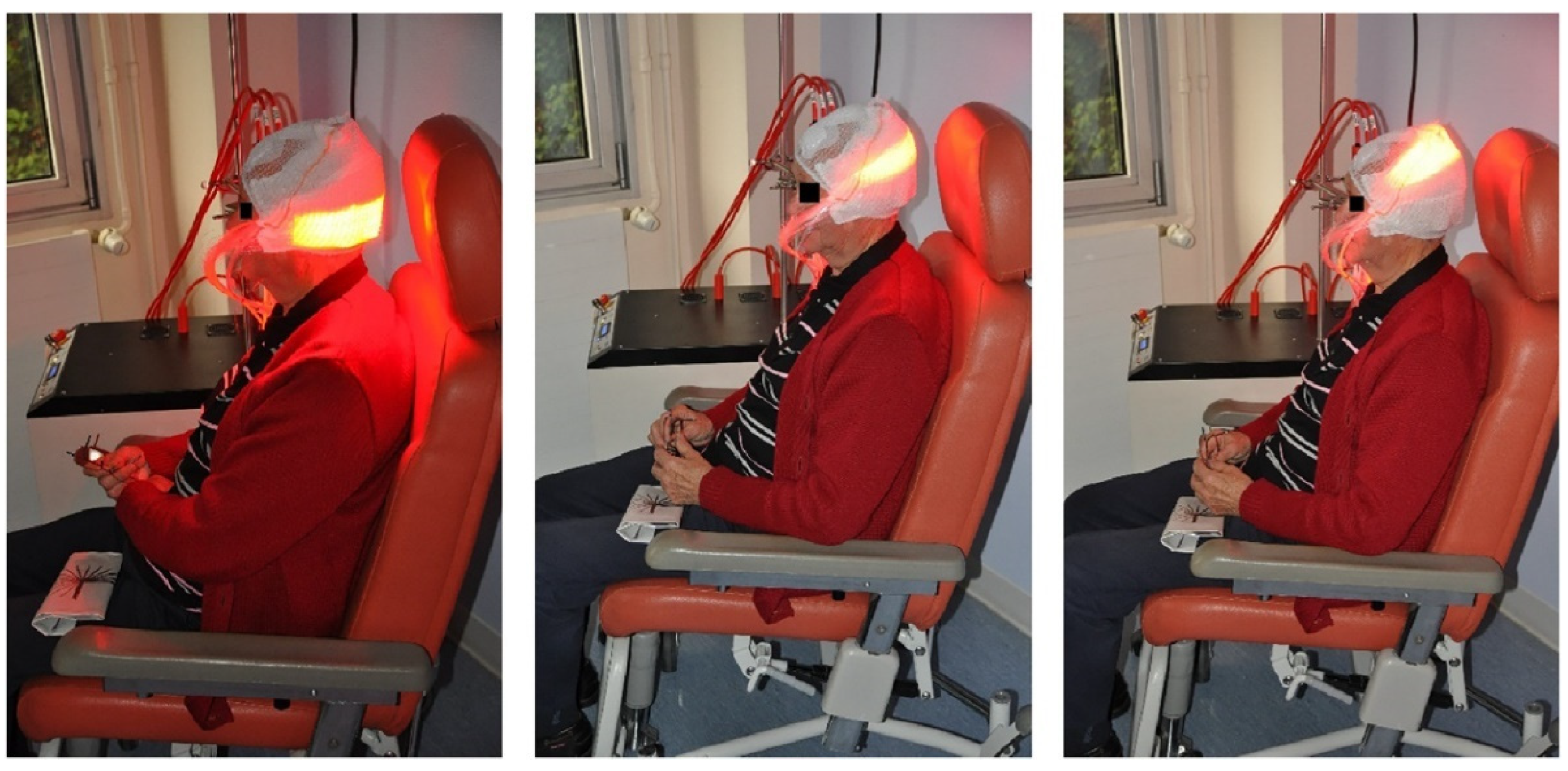

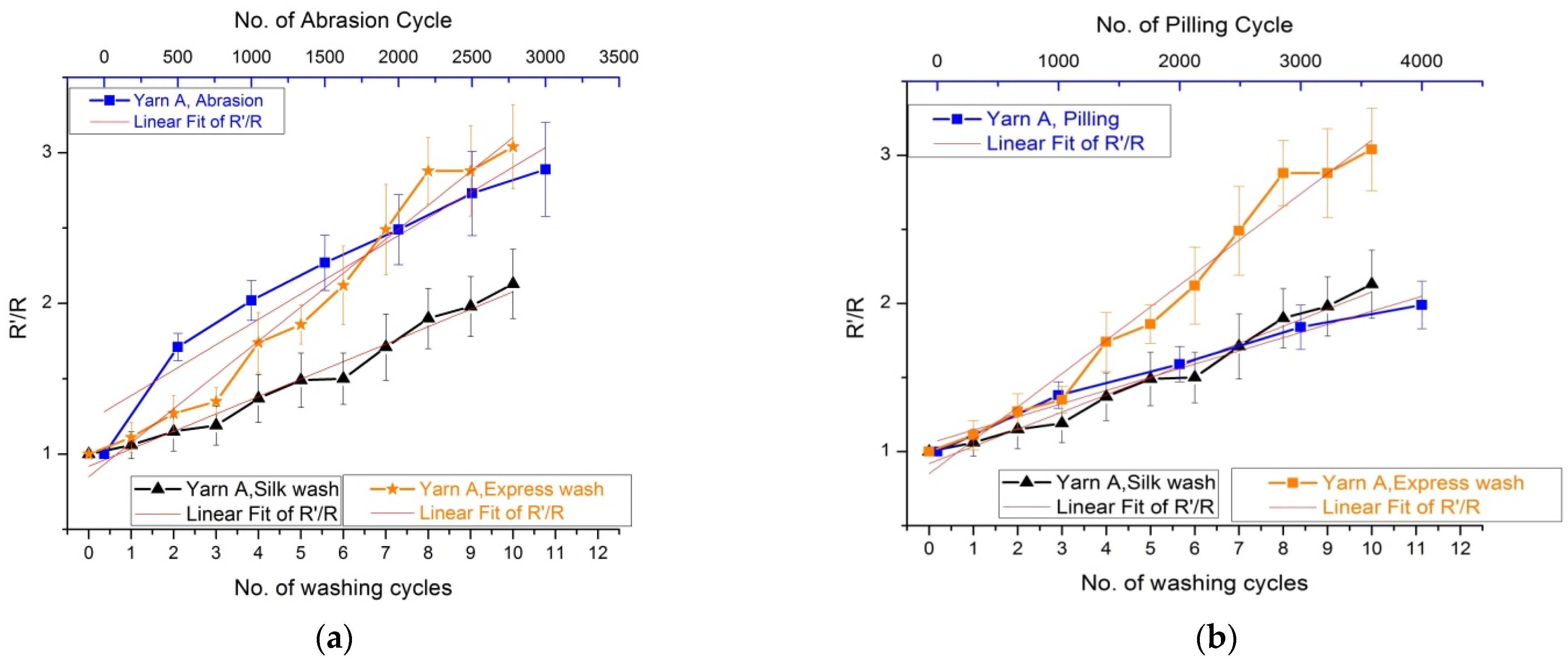

| Brand | Max. Temp. | Instructions | Machine Wash | Product Availability (Price) |
|---|---|---|---|---|
| Kymira heart monitoring t-shirt | 30 °C | Do not tumble dry | Yes | Not available |
| Xiaomi Mijia smart t-shirt | 30 °C | Gentle wash | No | Available (US $69) |
| Sensoria fitness smart t-shirt | Remove sensors before washing | Yes | Available (US $129) | |
| Emglare smart shirt | 30 °C | Minimal washing | Yes | Pre-order (US $249) |
| AiQ Sports Bra | Machine washable | Yes | Not available | |
| HealthWatch ECG t-shirt | Home machine washable | Yes | Demo | |
| CuteCircuit smart shirt | Washable | No | Pre-order (£550) |
| Authors | Targeted Area | Manufacturing Technique | Conductive Material Used |
|---|---|---|---|
| Meghrazi et al. [67] | ECG at waist position | Multi-channel knitted textile | Carbon/Silver |
| Arquilla et al. [69] | ECG at chest mount | Sewn textile | Silver coated threads |
| Wang et al. [70] | ECG in undergarments | Weft-knitted | Silver-plated nylon filament yarn |
| Shathi et al. [71] | ECG at various positions | Pad-dry-cure method | Graphene-based electrodes |
| Bystrickt et al. [36] | ECG in tops and the straps | Knitted and embroidered | silveR.STAT® and X-STATIC |
| Saleh et al. [72] | ECG | The cotton textile reduction process | Reduced graphene oxide cotton electrodes |
| Nigusse et al. [74] | ECG | Knitted cotton and polyester fabric | Screen-printed electrodes |
| Gaubert et al. [46] | Urine leakage sensors | Seamlessly integrated into textile underwear | Stainless steel and silver-plated conductive yarns. |
| Shathi et al. [71] | Pulse rate sensor | Pad-dry-cure method | Graphene coated textile |
| Atakan et al. [77] | Accelerometers and gyroscope sensors | Knitted band | Elastomeric nylon yarn and IMU sensor |
| Cao et al. [78] | Finger movement analysis (strain) | Screen printing | Carbon nanotubes (CNT) |
| Zhao et al. [81] | Strain sensor | Weaved | PET-based Ag sensors |
| Kim et al. [15] | Pressure sensor | Sewn | Conductive wool yarn |
| Danova et al. [87] | Piezoresistive elastic sensors | Welded directly on the t-shirt | Multiwall carbon nanotubes (MWCNTs) |
| Authors | Targeted Area | Manufacturing Technique | Conductive Material Used |
|---|---|---|---|
| Shin et al. [91] | Light therapy | Used in weft insertion during weaving | (PMMA) fiber core and a fluorinated PMMA derivative cladding |
| Cinquino et al. [90] | Light therapy | LEDs/OLEDs coupled with POF (polymer optical fibers) | POF (polymer optical fibers) |
| Mordon et al. [92] | Photodynamic treatments (dermatology treatments) | Optical fiber is woven by conventional methods | Optical fibers |
| Shahariar et al. [94] | Wearable textile heaters | Direct-write printing | PET non-woven, TPU, nylon PET non-woven |
| Shahariar et al. [94] | Neonatal jaundice treatments | Woven | Polymer optical fibers (POF) |
Publisher’s Note: MDPI stays neutral with regard to jurisdictional claims in published maps and institutional affiliations. |
© 2021 by the authors. Licensee MDPI, Basel, Switzerland. This article is an open access article distributed under the terms and conditions of the Creative Commons Attribution (CC BY) license (https://creativecommons.org/licenses/by/4.0/).
Share and Cite
Zaman, S.u.; Tao, X.; Cochrane, C.; Koncar, V. Smart E-Textile Systems: A Review for Healthcare Applications. Electronics 2022, 11, 99. https://doi.org/10.3390/electronics11010099
Zaman Su, Tao X, Cochrane C, Koncar V. Smart E-Textile Systems: A Review for Healthcare Applications. Electronics. 2022; 11(1):99. https://doi.org/10.3390/electronics11010099
Chicago/Turabian StyleZaman, Shahood uz, Xuyuan Tao, Cedric Cochrane, and Vladan Koncar. 2022. "Smart E-Textile Systems: A Review for Healthcare Applications" Electronics 11, no. 1: 99. https://doi.org/10.3390/electronics11010099
APA StyleZaman, S. u., Tao, X., Cochrane, C., & Koncar, V. (2022). Smart E-Textile Systems: A Review for Healthcare Applications. Electronics, 11(1), 99. https://doi.org/10.3390/electronics11010099









